ISSN ONLINE(2319-8753)PRINT(2347-6710)
ISSN ONLINE(2319-8753)PRINT(2347-6710)
| S.Pandikumar and R.S. Vetrivel Dept of Computer Science, Subbalakshmi Lakshmipathy College of Science, India. |
| Related article at Pubmed, Scholar Google |
Visit for more related articles at International Journal of Innovative Research in Science, Engineering and Technology
In 21st century the people wants the world on their hands. It outlets the revolutions of computing and smart environment. Some technologies like Ubiquitous/pervasive and ambient intelligence satisfy the maximum need of smart world but these technologies are not tightly coupled with internet, so the people needs another technology extension. Internet of Things (IoT) is an ideal emerging technology to influence the internet and communication technologies. Simply “Internet of Things” connects „living and non living things‟ through „internet‟. Traditionally in the object oriented paradigm everything in the world is considered as an object, but in the IoT paradigm everything in the world is considered as a smart object, and allows them to communicate each other through the internet technologies by physically or virtually. IoT allows people and things to be connected Anytime, Anyplace, with Anything and Anyone, by using ideally in Any path/network and Any service. This paper proposes architecture to enable the users to control and monitor smart devices through internet. It creates an interface between users and smart home by using GSM and internet technologies, or it simply creates GSM based wireless communication from the web server into the smart home. In this architecture the users give commands through web then the users inputs are converted into GSM-SMS commands. These commands are sent to embedded system module (embedded system directly connect with devices) through GSM network, and finally the user commands are parsed and executed by microcontroller to control any electronic objects like home appliances, lights, etc and it sends the acknowledgement. The embedded system module can place anywhere in the world and it will controlled by IoT Agent through GSM network.
Keywords |
| GSM, Internet of Things, SMS, Web Interface, Smart Home. |
INTRODUCTION |
| Every day the modern people expect new device and new technology to simplify their day to day life. The innovators and researchers are always trying to find new things to satisfy the people but the process is still infinite. In the 1990s, Internet connectivity began to proliferate in enterprise and consumer markets, but was still limited in its use because of the low performance of the network interconnects. In the 2000s Internet connectivity became the norm for many applications and today is expected as part of many enterprise, industrial and consumer products to provide access to information. However, these devices are still primarily things on the Internet that require more human interaction and monitoring through apps and interfaces. One research reveals, the Internet of Things (IoT), which excludes PCs, tablets and smart phones, will grow to 26 billion units installed in 2020 representing an almost 30-fold increase from 0.9 billion in 2009[1]. |
| The Internet of Things is a new era of intelligence computing and itâÃâ¬ÃŸs providing a privilege to communicate around the world. The objective of IoT is Anything, Anyone, Anytime, Anyplace, Anyservice and Anynetwork [2]. |
| Fig.1 describes the coupling of CâÃâ¬ÃŸs and AâÃâ¬ÃŸs. That reveals, people and things can be connected Anytime, Anyplace, with Anything and Anyone, ideally by using in Anypath/network and Any service. This implies addressing elements such as Convergence, Content, Collections (Repositories), Computing, Communication, and Connectivity in the context where there is seamless interconnection between people and things and/or between things and things so the A and C elements are present and tightly coupled. |
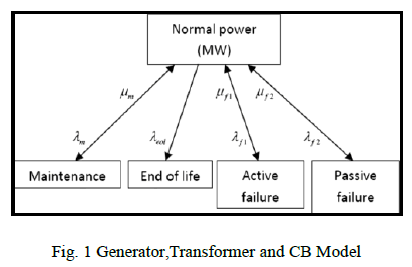 |
| This paper propose a novel architecture of IoT enabled smart home which is control and monitor smart devices through GSM and Internet Technologies. Normally the smart homes will be conscious about what happens inside a building, mainly impacting three aspects: |
| • resource usage (water conservation and energy consumption etc), |
| • security and |
| • Comfort. |
| The architecture designs are imposed on these three functionalities. The user can control or check the status of any resources or enable/disable security options of the smart home. This paper introduces a IoT agent which is brain of this architecture and it controls web server and remote embedded system module. At very short period of time the IoT agent reads the user data from the webserver, createa a SMS command and it will be sent to remote embedded system module through GSM-SMS. This command will be received by GSM receiving module which is connected with embedded system placed in a remote home. The home appliances and other devices are directly connected and controlled by this embedded system module. The GSM module is inbuilt with IoT agent and embedded system module. After executing the commands the acknowledgement will be sent to user. |
BACKGROUND STUDY |
| The concept of the Internet of Things first became popular through the Auto-ID Center at MIT and related market analysis publications.[2] Radio-frequency identification (RFID) was seen as a prerequisite for the Internet of Things in the early days. If all objects and people in daily life were equipped with identifiers, they could be managed and inventoried by computers. Besides using RFID, the tagging of things may be achieved through such technologies as near field communication, barcodes, QR codes, Mobile Computing, Ambient Intelligence. |
| Jayavardhana Gubbi, Louis Coetzee et al. [12, 14] describes the origin and vision of IoT and the paper investigated and analyzed applications, challenges and future trends of IoT. Chonggang Wang et al. [13] broadly discussed the state of the art of IoT. Yin Jie proposed a novel idea of applying IoT technologies to smart home [9]. Alberto M.C et al. proposed an architecture for accessing smart home devices through web clients. The paper uses LinkSmart Middleware layer to create interface between web server and embedded system unit. The embedded system physically connects with web server and act as a gateway to the devices [3]. |
| Tengfei Zhang, Perumal, T et al. [4][11] introduced new solution to create a interface between user and smart home using GSM and IoT. Ming Wang et al. [5] developed smart central controller to set up a radio frequency 433 MHz wireless sensor and actuator network (WSAN). A series of control modules, such as switch modules, radio frequency control modules, have been developed in the WSAN to control all kinds of home appliances directly. Application servers, client computers, tablets or smart phones can communicate with the smart central controller through a wireless router via a Wi-Fi interface. |
| Yepeng Ni and Sun Yi et al. [6][10] introduced lightweight Wi- Fi–ZigBee wireless home gateway to access smart home devices. ZigBee technology used to transmit the data collected from the node network to the embedded gateway, and then communicates with the monitoring PC by Wi-Fi network. Wi-Fi module used to send commands from monitoring PC to ZigBee network, and then control home device. Yuanxin Lin et al. [8] present a Smart Home Monitoring System to achieve the remote access of home devices to the Internet and the ZigBee shortrange wireless sensor networks connect with terminal. Kelly, S.D.T et al. [7] proposed the framework of the monitoring regular domestic conditions by means of low cost ubiquitous sensing system using IoT. It is based on a combination of pervasive distributed sensing units, information system for data aggregation, and reasoning and context awareness. |
| Ashna, K [15] presents the design of a simple low cost wireless GSM energy meter and its associated web interface, for automating billing and managing the collected data globally. Xufeng Ding [16] design a distributed heterogeneous wireless sensor network for agriculture environmental monitoring and early warning system based on Internet of Things technologies. The system includes a ZigBee coordinator node, multiple ZigBee sensor nodes, multiple ZigBee routing nodes, a GSM SMS module, and the management software based on SQL running on the remote control center PC. |
OVERVIEW OF INTERNET OF THINGS |
| In the digital world, especially the computer commun - ication starts with sharing data between machine to machine, and it moves to machine to infrastructure, then machine to environment, and machine to people but now internet is everything. |
| The people also want to communicate with all non living things through internet such as home appliances, furnitureâÃâ¬ÃŸs, stationeries, cloths etc. The people already have a lot of technologies to interact with living things but IoT enables to communicate with non living things with comfort manner. IoT is a convergence of several technologies like ubiquitous, pervasive computing, Ambient Intelligence, Sensors, Actuators, Communications technologies, Internet Technologies, Embedded systems etc see Fig. 2. |
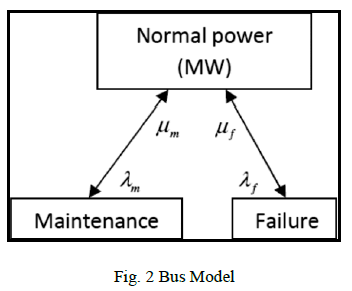 |
| Fig. 3 Functional Classification of IoT |
| In the IoT architecture, “Internet Oriented” represents internet and its technologies and it act as a middleware between user and intelligent things and so itâÃâ¬ÃŸs called as intelligent middleware. Intelligent middleware will allow the creation of a dynamic map of the real/physical world within the digital/virtual space by using a high temporal and spatial resolution and combining the characteristics of ubiquitous sensor networks and other identifiable “things” [2]. |
| “Things Oriented” is known as “Intelligent Things” which represents sensors and actuators which is respond it to stimuli from the environment in a consistent manner. This phase sense and react based on the environment and user actions such as When white light is shone on a red object the dye absorbs nearly all the light except the red, which is reflected. At an abstract level, the colored surface is an interface for the object, and the light arriving at object can be a message sent to the thing, and accordingly its reflection is the response from the thing. The consistency in responses received from the interfaces for each message, enables things to interact with their surroundings. Hence to make the virtual world comprehensible, there needs to be consistency in messages and it responses. This is enabled through standard interfaces, which is in turn to facilitate interoperability. Simply this phase focuses the functionalities and communications among sensor/actuators, embedded devices and any other smart devices. |
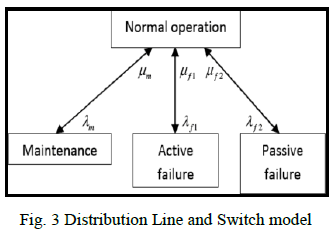 |
APPLICATIONS OF IoT |
| The potentialities offered by the IoT make it possible to develop numerous applications based on it. All the applications are comprised in many more smart “things” such as sensors, actuators, microcontrollers etc. Antoine de Saint-Exupery [2] classifies IoT applications are three major categories they are |
| • Society |
| • Environment |
| • Industry. |
| Based on the classification the term “Things” can be perceived in a different way and depending on the application domain in which it is used. In Industry, all IoT Activities are involving in financial or in commercial transactions among companies, organizations and other entities such that Manufacturing, logistics, Service Sector, Banking, Financial Governmental Authorities, Intermediaries, etc. On the whole the “Thing” may typically be the product itself, the equipment, transportation means, etc; everything that participates in the product lifecycle. |
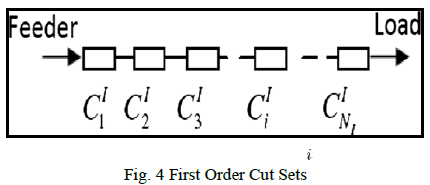 |
| In Environment applications based on the activities regarding the protection, monitoring and development of all natural resources such as Agriculture & breeding, recycling, environmental management services, energy management, etc. |
| Lastly, in the whole society the “Thing” may be related to devices within public spaces or devices for Ambient Assisted Living, etc. For example Agriculture & breeding, recycling, environmental management services, energy management, smart home, smart city, smart office etc. |
ARCHITECTURE |
| Today, Global System for Mobile Communication is a vital communication technology and the proposed architecture uses GSM is a primary communication technology between the home and IoT agent. The IoT agent is the core part of this architecture because it manages web server data, SMS command, GSM module interactions and all knowledge based processes (parsing, analysis and creation of SMS commands). |
| A. Web Users |
| The web users are common people, this architecture provides them to know the status of the home devices and control (ON or OFF) the devices. The user can send the commands through any web enabled devices like PC, Tablet, iPOD, smart phones or any WAP enabled devices. |
| B. Web Server |
| Web server might be a Tomcat, Apache, IIS etc. and it must have internal database. The user data kept in the centralized database and it will read by IoT agent through COM or DCOM, API or any other ODBC. The web server is not involved to parsing and knowledge processes. It belong only request and response to the user and stores the data. The web server have internal timer to refresh the web page to update the status of the smart home devices. The IoT agent also have internal timer to refresh the status of the devices from the embedded module |
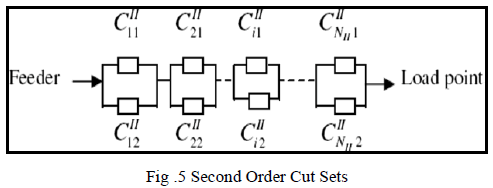 |
| C. IoT Agent |
| The IoT is the software and hardware unit which continuously monitors Web server and GSM module for incoming SMS from smart home. The special SMS has unique structure which is constructed by microcontroller of embedded unit. Once the NEW_MESSAGE_RECEIVED event generated by GSM module the IoT Agent reads newly arrived SMS and check it whether special SMS or not. If it so, it parse and extract the data. The special SMSs are always start and end with special symbol like „#âÃâ¬ÃŸ,âÃâ¬ÃŸ@âÃâ¬ÃŸ,âÃâ¬ÃŸ&âÃâ¬ÃŸ, etc. and this paper uses „#âÃâ¬ÃŸ symbol. After confirming special SMS, the IoT Agent parse the data based on <SPACE> or <ENTER> or whitespaces. For example the incoming SMS like “#R1L001 1 <enter> R2L002 0 <enter> KL001 0 <enter>HF001 0<enter> HL001 1 #” In this example agent checks starting character and then parse SMS into actual parameters like |
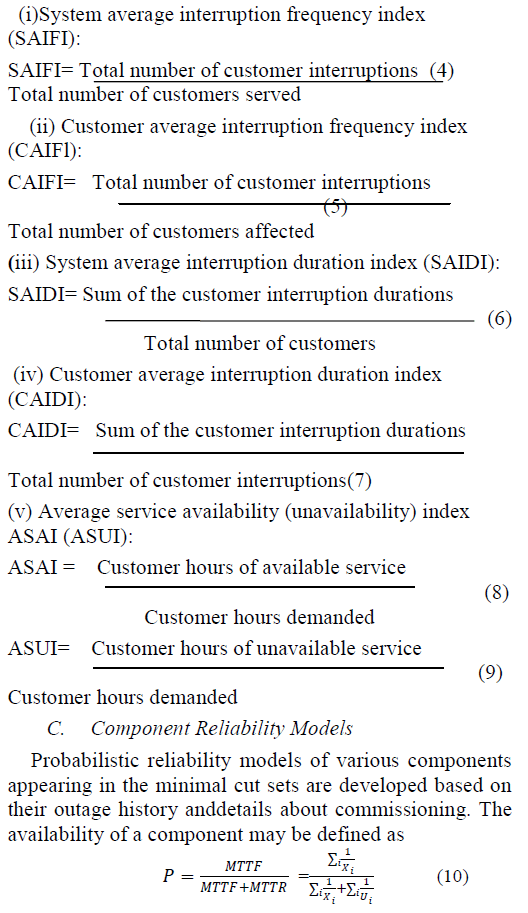 |
| In the SMS commands R represents Rooms, L represents Lights, K represents Kitchen, H represents Hall. If the device is ON or OFF, represents 1 or 0. This parsed data will be executed by IoT Agent and Micro Controller. Some Sample SMS Commands are |
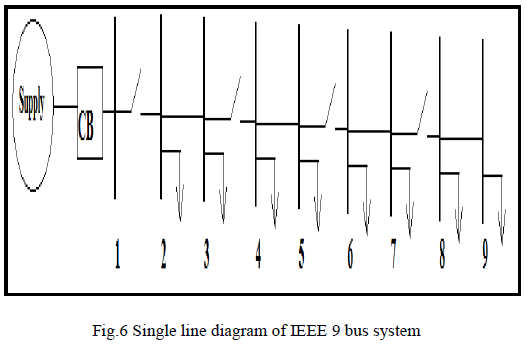 |
| The agent also continuously monitors web server for user inputs. The user can see the status of the home devices through the web client. The IoT agent maintains the current status of the devices and keeps updating with short period of time. The web server keeps refreshing the data to the web client. Whenever the user changes the status or gives any data, this will be updated in the webserver internal database then the IoT agent will handle the routine process based on the data. |
GSM INTERFACE |
| The GSM receiving module acts as a gateway in communication module. This receiving module can be a GSM/GPRS modem, mobile phone or any SMS send/receiving device. This device connects with computer and microcontroller through USB or serial cable [17]. The AT (Attention) commands are used to manage connections and to send/receive the SMS. The IoT Agent will receive SMS by NEW_MESSAGE_RECEIVED event. When new SMS arrived the agent parsed and process what the SMS command tells. Sample AT Commands are “AT+CMGL” List messages, “AT+CMGR” Read message, “AT+CMGS” Send message [17]. The interface module communicates with GSM device and reads the SMS and checks whether itâÃâ¬ÃŸs a special SMS or ordinary SMS. If itâÃâ¬ÃŸs a command SMS, this commands are executed by IoT Agent. |
| A. Measurement of SMS Transfer Rate |
| In GSM architecture SMS messages are carried on either SD-CCH or SACCH [19] depending on the use of the traffic channel. When the TCH (Traffic Channels) is not allocated, i.e., no voice call or data transfer are in progress, but the short message is carried on the SDCCH (stand alone dedicated control channel). In this architecture the GSM module does not commit TCH but it does dedicate to send SMS only. So itâÃâ¬ÃŸs always use SDCCH to send SMS. Basically the SMS delivery is based on network, location and time [18, 19]. |
 |
SMART DEVICE INTERFACE |
| The interface between devices and embedded system is established by physical connection using cables. |
| A. Microcontroller |
| Microcontroller (μÃâÃÂ) is the brain of this module because it controls the entire devices in the smart home directly. Whenever the new SMS is received in GSM modem μÃâàreads the message and execute. The μÃâàreads the device status and values. Then it constructs the special structured SMS and sends it to IoT Agent through GSM network. The μÃâàuses AT (Attention) commands to access GSM modem [20]. In this proposed architecture the μÃâàcan support Xn devices and one GSM module. The μÃâàcreates interface with GPS and GSM components through RS232 protocol. |
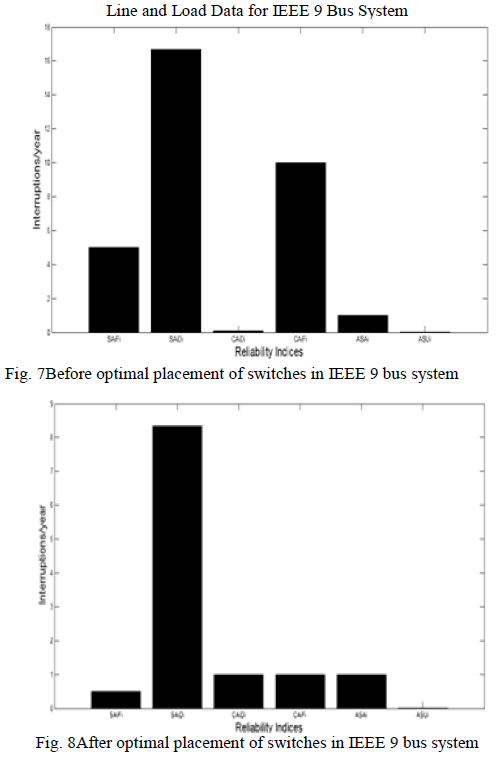 |
EXPERIMENTAL WORK |
| The prototype model developed and tested with frequently used technologies. The embedded module placed in a typical home and attached with minimum devices. This home has one room, one hall, one kitchen and one comfort and totally 5 CFL lights, 3 Fans and one mixer grinder. Fig.10 illustrates the screens accessible through the browser. The application has been developed using ASP.Net and SQL Server 2012 technology [21-23] that accesses the web services as a developed interface to the IoT Web Access. |
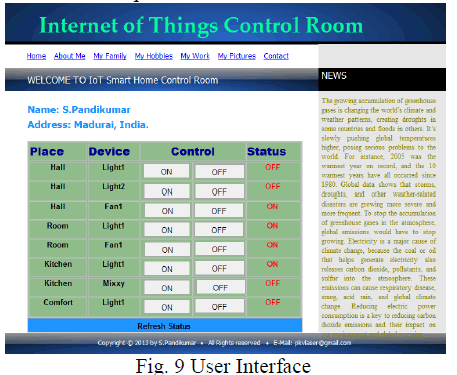 |
| Figure 9 illustrates the main page to access and interact with the smart home devices. The user can visualize the status of the houseâÃâ¬ÃŸs devices. In this example, the status of lights and Fans in the room, kitchen, Hall and comfort displayed. The user can turn ON or OFF any lamp or device. The IoT Agent module developed using C#4.0 and it perfectly makes serial port and database communication through API. The agent continuously keeps update the status about every100 milliseconds. |
PERFORMANCE ANALYSIS |
| In this experimental work the IoT agent is the responsible for send and receive the command SMS to/from the embedded system. Figure 8 shows the variations of SMS delivery time between 8 AM to 10 PM. Here the lowest delivery time of command SMS is one second at 2:10PM and the highest delivery time is 6 seconds at 7:50PM. The average delivery time of this architecture is 3.5 seconds and zero data lose. |
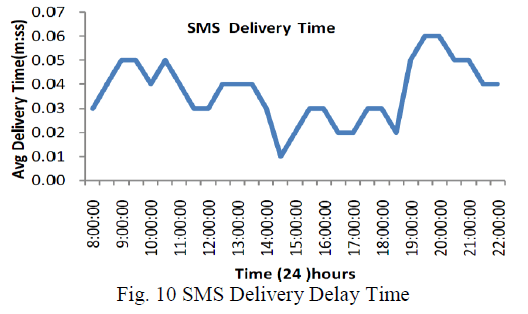 |
CONCLUSION |
| This paper presents an IoT and GSM based design of smart home controlling system. Prototype operates for data gathering and transmission using GSM-SMS and preliminary test prove that the developed prototype is capable to monitor and control devices in the deployed environment and has several advantages in term of fast delivery, zero data lose, low cost, flexibility, user friendliness and energy efficiency. The established GSM network is a highly efficient and the average SMS deliver time is 3.5 sec. It is important to note the following attributes of the application: the user interfaces are simple and intuitive. |
| In future this architecture will be extend to implement with video streaming of home activities using GSM-MMS and RTMP protocol and improve the security of the data transmission and authentication process. |
References |
|